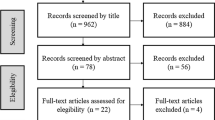Abstract
Introduction and hypothesis
To compare the effects of pelvic floor muscle training (PFMT), with or without biofeedback (BF), for stress urinary incontinence (SUI), focusing on condition-specific quality of life (QOL) outcomes.
Methods
Women with SUI were randomized to PFMT with BF (BF group, n = 23) or without BF (PFMT group, n = 23) for 12 weeks. As primary outcome measures, subjective symptoms and QOL were assessed by the King’s Health Questionnaire (KHQ) and International Consultation on Incontinence Questionnaire-Short Form (ICIQ-SF). A voiding diary, 1-h pad test, and measurement of PFM strength were secondary outcome measures. Changes in the primary and secondary outcomes were assessed before and after 12 weeks’ exercise training.
Results
Of the 9 domains of the KHQ, the scores of 5 significantly decreased in the PFMT group, and the scores of 7 significantly decreased in the BF group. All ICIQ-SF items and the total score significantly decreased in both groups after therapy. The number of incontinence episodes significantly decreased in the PFMT group, and tended to decrease in the BF group, but this was not significant (P = 0.054). The leakage volume in the 1-h pad test tended to decrease in both groups, but was not significant. Maximum vaginal squeeze pressure significantly increased in both groups. There were no significant inter-group differences in the changes in any of the parameters assessed.
Conclusions
The results indicate that PFMT is effective for treating SUI. There is no apparent add-on effect of BF training in short-term follow-up.

Similar content being viewed by others
References
Haylen BT, de Ridder D, Freeman RM et al (2010) An International Urogynecological Association (IUGA)/International Continence Society (ICS) joint report on the terminology for female pelvic floor dysfunction. Int Urogynecol J 21:5–26
Hannestad YS, Rortveit G, Sandvik H et al (2000) A community-based epidemiological survey of female urinary incontinence: the Norwegian EPINCONT study. J Clin Epidemiol 53:1150–1157
Dumoulin C, Hay-Smith J (2010) Pelvic floor muscle training versus no treatment, or inactive control treatments, for urinary incontinence in women. Cochrane Database Syst Rev CD005654
Berghmans LC, Frederiks CM, de Bie RA et al (1996) Efficacy of biofeedback, when included with pelvic floor muscle exercise treatment, for genuine stress incontinence. Neurourol Urodyn 15:37–52
Glavind K, Nøhr SB, Walter S (1996) Biofeedback and physiotherapy versus physiotherapy alone in the treatment of genuine stress urinary incontinence. Int Urogynecol J Pelvic Floor Dysfunct 7:339–343
Pages IH, Jahr S, Schaufele MK, Conradi E (2001) Comparative analysis of biofeedback and physical therapy for treatment of urinary stress incontinence in women. Am J Phys Med Rehabil 80:494–502
Aukee P, Immonen P, Penttinen J, Laippala P, Airaksinen O (2002) Increase in pelvic floor muscle activity after 12 weeks’ training: a randomized prospective pilot study. Urology 60:1020–1024
Mørkved S, Bø K, Fjørtoft T (2002) Effect of adding biofeedback to pelvic floor muscle training to treat urodynamic stress incontinence. Obstet Gynecol 100:730–739
Aksac B, Aki S, Karan A, Yalcin O, Isikoglu M, Eskiyurt N (2003) Biofeedback and pelvic floor exercises for the rehabilitation of urinary stress incontinence. Gynecol Obstet Investig 56:23–27
Schmidt AP, Sanches PR, Silva DP Jr, Ramos JG, Nohama P (2009) A new pelvic muscle trainer for the treatment of urinary incontinence. Int J Gynaecol Obstet 105:218–222
Herderschee R, Hay-Smith EJ, Herbison GP, Roovers JP, Heineman MJ (2011) Feedback or biofeedback to augment pelvic floor muscle training for urinary incontinence in women. Cochrane Database Syst Rev CD009252
Miller JM, Ashton-Miller JA, DeLancey JO (1998) A pelvic muscle precontraction can reduce cough-related urine loss in selected women with mild SUI. J Am Geriatr Soc 46:870–874
Kelleher CJ, Cardozo LD, Khullar V, Salvatore S (1997) A new questionnaire to assess the quality of life of urinary incontinent women. Br J Obstet Gynaecol 104:1374–1379
Okamura K, Nojiri Y, Osuga Y (2009) Reliability and validity of the King’s Health Questionnaire for lower urinary tract symptoms in both genders. BJU Int 103:1673–1678
Avery K, Donovan J, Peters TJ, Shaw C, Gotoh M, Abrams P (2004) ICIQ: a brief and robust measure for evaluating the symptoms and impact of urinary incontinence. Neurourol Urodyn 23:322–330
Gotoh M, Donovan J, Corcos J et al (2001) Scored ICIQ-SF (International Consultation on Incontinence Questionnaire-Short Form) for symptoms and QOL assessment in patients with urinary incontinence. JNBS 12:227–231 [in Japanese]
Gotoh M, Homma Y, Funahashi Y, Matsukawa Y, Kato M (2009) Psychometric validation of the Japanese version of the International Consultation on Incontinence questionnaire-short form. Int J Urol 16:303–306
Cohen J (1988) The effect size. In: Cohen J (ed) Statistical power analysis for the behavioral sciences. Lawrence Erlbaum Associates, Hillsdale, pp 77–83
Rett MT, Simoes JA, Herrmann V, Pinto CL, Marques AA, Morais SS (2007) Management of stress urinary incontinence with surface electromyography-assisted biofeedback in women of reproductive age. Phys Ther 87:136–142
Homma Y, Yamaguchi O, Hayashi K, Neurogenic Bladder Society Committee (2006) Epidemiologic survey of lower urinary tract symptoms in Japan. Urology 68:560–564
Dumoulin C, Glazener C, Jenkinson D (2011) Determining the optimal pelvic floor muscle training regimen for women with stress urinary incontinence. Neurourol Urodyn 30:746–753
Prashar S, Simons A, Bryant C, Dowell C, Moore KH (2000) Attitudes to vaginal/urethral touching and device placement in women with urinary incontinence. Int Urogynecol J Pelvic Floor Dysfunct 11:4–8
Chehrehrazi M, Arab AM, Karimi N, Zargham M (2009) Assessment of pelvic floor muscle contraction in stress urinary incontinent women: comparison between transabdominal ultrasound and perineometry. Int Urogynecol J Pelvic Floor Dysfunct 20:1491–1496
Lose G, Rosenkilde P, Gammelgaard J, Schroeder T (1988) Pad-weighing test performed with standardized bladder volume. Urology 32:78–80
Acknowledgements
Part of this study was sponsored by Medical Taskforce Co., Ltd. We wish to thank the NPO Aichi Society for Excretion Care.
Conflicts of interest
None.
Financial disclaimers
None.
Author information
Authors and Affiliations
Corresponding author
Rights and permissions
About this article
Cite this article
Hirakawa, T., Suzuki, S., Kato, K. et al. Randomized controlled trial of pelvic floor muscle training with or without biofeedback for urinary incontinence. Int Urogynecol J 24, 1347–1354 (2013). https://doi.org/10.1007/s00192-012-2012-8
Received:
Accepted:
Published:
Issue Date:
DOI: https://doi.org/10.1007/s00192-012-2012-8




